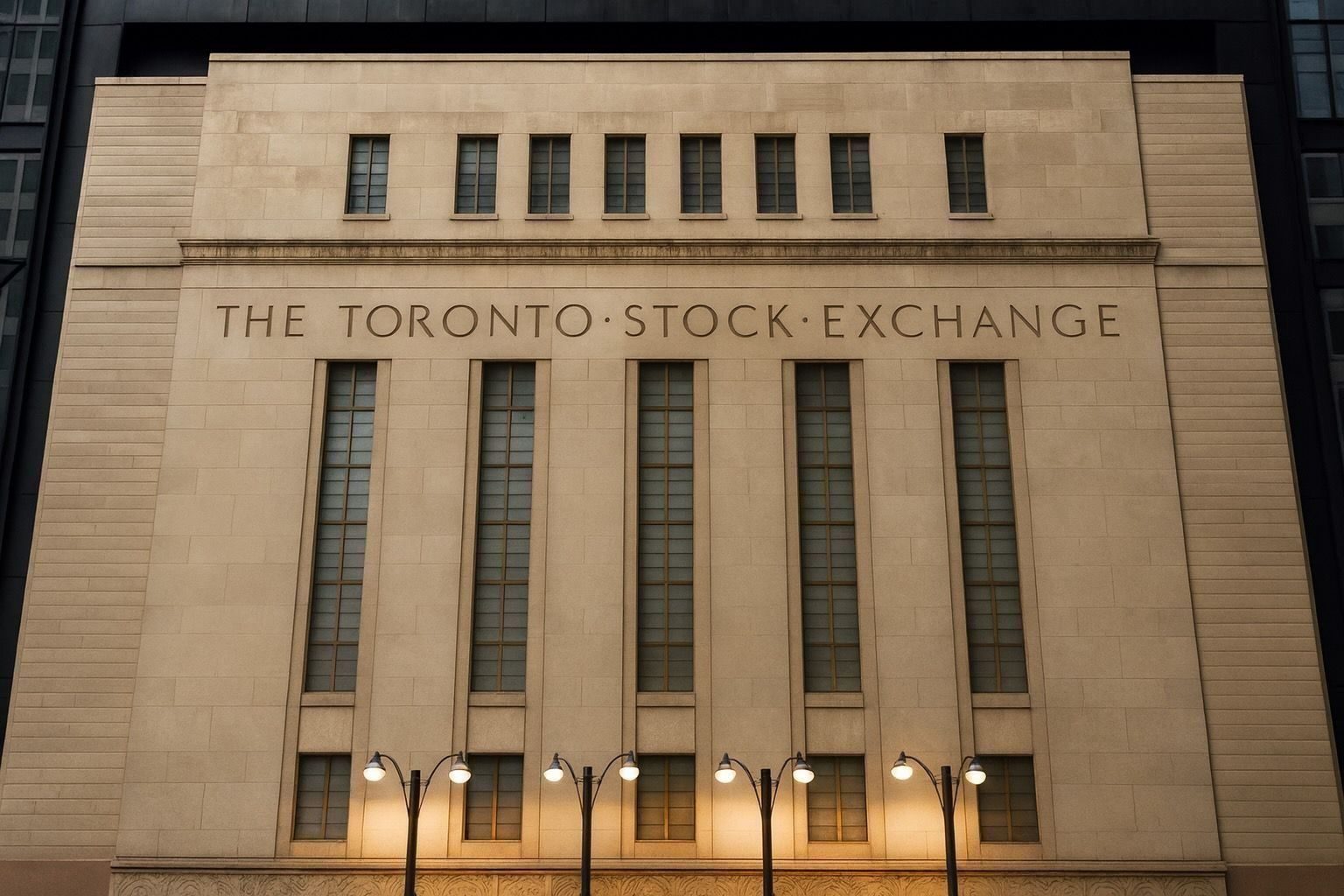Canada’s stock market closed out the week on a strong note Friday, with the S&P/TSX Composite Index edging to yet another record high as a surprisingly strong Q3 GDP report lifted confidence in the domestic outlook and boosted the Canadian dollar.
Market Wrap: TSX Extends Record Run
Canada’s benchmark S&P/TSX Composite Index finished Friday at 31,269.62, up 0.23% on the day. That’s about 73 points above Thursday’s record close of 31,196.71, marking a new all‑time closing high and extending the winning streak to six straight sessions. [1]
Intraday, the benchmark hovered just above the 31,200 mark, with gains modest but enough to “loosely extend” the week’s sharp rally of roughly 3.5%–3.7%, according to index data and Trading Economics commentary. [2]
By the numbers:
- Close: 31,269.62
- Day’s range: 31,151.65 – 31,294.53 [3]
- Daily change: +0.23%
- Weekly change (vs. last Friday’s 30,160.65): ≈ +3.7% [4]
- Month‑to‑date (vs. Oct. 31 close around 30,260): ≈ +3.3% [5]
- 12‑month change: about +22% for the Composite, based on index data. [6]
The S&P/TSX Venture Composite Index, a barometer for small‑cap and resource‑heavy names, had an even better day, jumping about 2.1–2.2% to roughly 942, extending a powerful late‑November rebound in junior miners and speculative growth stocks. [7]
GDP Shock: Strong Headline, Mixed Under the Hood
Friday’s main macro catalyst was the Q3 GDP report, which came in far stronger than economists had expected.
According to Statistics Canada data reported by Reuters, Canada’s economy grew at an annualized 2.6% in the third quarter, versus a consensus call for just 0.5%. Real GDP rose 0.6% quarter‑over‑quarter after a 0.5% contraction in Q2, meaning Canada narrowly avoided the “technical recession” that many had feared. [8]
Key details from the report:
- Trade drove the rebound. Exports rose while imports fell, with crude oil and bitumen exports up around 6–7%, giving a sizeable lift to growth. [9]
- Government capital spending jumped, particularly on weapon systems and non‑residential structures such as hospitals, helping offset the drag from tariffs and global uncertainty. [10]
- Household consumption slipped slightly, and business capital investment was flat, underscoring softer domestic demand even as headline GDP impressed. [11]
- September GDP grew 0.2% m/m, matching expectations, but a flash estimate for October points to a 0.3% decline, suggesting a weaker start to Q4. [12]
For markets, the message is nuanced:
Canada’s economy is stronger than feared, but the growth story is heavily supported by trade and public investment, not by roaring consumer or business demand. That mix helps explain why stocks reacted positively but rate‑sensitive corners of the market — like real estate — lagged.
How the Session Unfolded: From Soft Open to Record Close
At the opening bell, the mood on Bay Street was cautious.
Reuters reported that at 9:31 a.m. ET, the S&P/TSX Composite was down about 0.12% at 31,159.66, with real estate stocks leading early declines as investors digested the GDP numbers and what they might mean for interest rates and bond yields. [13]
As the session wore on, however, investors rotated back toward resources and quality cyclicals, helped by:
- A rebound in gold prices, tied to growing expectations of a U.S. Federal Reserve rate cut as early as December, and
- Firm oil prices, amid ongoing geopolitical tensions and energy‑market jitters. [14]
By late afternoon, that buying interest was enough to nudge the Composite to a new closing peak just below its 52‑week intraday high around 31,300. [15]
Sector Snapshot: Resources and Rails Up, Real Estate Down
1. Materials & Gold Miners
Gold’s rise on Friday — driven partly by softer U.S. dollar expectations and Fed‑cut bets — gave fresh support to Canada’s heavyweight mining complex. Trading Economics reporting via TradingView highlighted Wheaton Precious Metals up roughly 1.6%, one of several gold royalty and mining names helping to pull the Composite higher. [16]
With gold miners having already enjoyed a strong November on the back of AI‑driven demand for copper and metals, Friday’s move added to the momentum that pushed the TSX to those fresh highs earlier in the week. [17]
2. Energy: Oil Majors Extend Gains
Crude prices also firmed, supported by lingering geopolitical risk. That helped Canadian Natural Resources, Suncor Energy and Cenovus Energy each add around half a percent or more during the session, according to Trading Economics commentary. [18]
Given that energy and materials together account for roughly one‑third of the TSX, continued strength in these groups has been a major driver of the index’s 20%+ gain so far in 2025. [19]
3. Industrials & Railways
In industrials, Canadian National Railway got an extra boost after CIBC upgraded the stock to “outperformer”, helping push the shares almost 0.9% higher on Friday. [20]
Rails are a key proxy for trade and economic activity, so the upgrade fits neatly with the positive GDP surprise and the narrative of stronger export‑led growth.
4. Financials: Banks in Focus
Financials traded more mixed. A Canadian Press analysis earlier in the day noted that Canada’s big banks are heading into the fourth quarter “priced for perfection,” with strong year‑to‑date share price gains leaving less room for disappointment in upcoming earnings. [21]
Investors are now watching:
- Net‑interest margins as the Bank of Canada nears the end of its easing cycle, and
- Credit quality trends, especially in consumer lending and commercial real estate.
5. Real Estate: Rate‑Sensitive Laggard
Real estate was the notable weak spot. Reuters reported that real estate stocks led early declines as markets weighed the possibility that stronger‑than‑expected GDP might slow the pace of future rate cuts or keep bond yields elevated. [22]
While the overall index recovered into the close, the sector remains sensitive to any shift in expectations for long‑term borrowing costs.
The Loonie Strengthens on GDP Beat
The currency market echoed the stock market’s cautious optimism.
- The USD/CAD exchange rate fell to around 1.3984, according to Trading Economics, a drop of roughly 0.3–0.4% on the day. [23]
- FXStreet noted that USD/CAD extended its losing streak to a fourth straight day as the Q3 GDP rebound supported the Canadian dollar, even as markets still expect the Bank of Canada to hold rates in December while the U.S. Federal Reserve leans toward a 25‑basis‑point cut. [24]
At those levels, the loonie is trading around 71.5 U.S. cents, a modest improvement that reflects:
- Better‑than‑feared Canadian growth,
- Rising resource prices, and
- Growing expectations of policy divergence between a steady BoC and a potentially easing Fed.
A stronger loonie is good news for importers and Canadians traveling abroad, but it can act as a mild headwind for exporters if the trend continues.
Small Caps & TSX Venture: Risk-On Mood Returns
Beyond the big‑cap Composite, risk appetite was clearly back in Canada’s junior market:
- The S&P/TSX Venture Composite Index closed around 941.99, up 2.16% on the day, according to Investing.com’s historical data. [25]
- Since last Friday’s close near 855, that’s a weekly jump of roughly 10%, powered by speculative mining and energy juniors regaining favour after a choppy autumn. [26]
Activity around resource juniors and tech micro‑caps suggests that investors are again willing to reach for higher‑beta names now that the macro backdrop — at least for Q3 — looks less recessionary than feared.
Corporate News to Watch on Bay Street
Several stock‑specific headlines also coloured trading on Friday:
1. Brookfield Infrastructure Renews Normal Course Issuer Bids
Brookfield Infrastructure Partners (BIP.UN) announced that the TSX has accepted its renewed normal course issuer bid, allowing it to repurchase up to 5% of its outstanding LP units (about 23 million units) and up to 10% of the public float for several preferred series, starting December 2, 2025 and running to December 1, 2026. [27]
The renewal underscores ongoing confidence from management in the valuation of its infrastructure portfolio and gives the partnership another lever to support per‑unit growth.
2. Pet Valu Renews Share Buyback
Pet retailer Pet Valu Holdings Ltd. (TSX: PET) said the TSX has accepted its notice to renew its normal course issuer bid, authorizing purchases of up to 3,449,181 common shares, or roughly 5% of its outstanding float. [28]
The company also entered into an automatic share purchase plan with a broker, allowing repurchases to continue during blackout periods within preset parameters. Management framed the move as a flexible way to manage capital and enhance shareholder value over the next 12 months. [29]
3. StorageVault Hybrid Debenture Offering
Self‑storage consolidator StorageVault Canada Inc. announced the successful closing of a $50 million bought‑deal offering of 5.60% senior unsecured hybrid debentures, providing additional capital for growth and refinancing. [30]
The debentures highlight continued investor appetite for yield‑bearing securities tied to alternative real‑asset platforms, even as rate expectations shift.
4. Other Notable Issuers and TSX‑V Names
- Kane Biotech (TSX‑V: KNE) and High Arctic Overseas (TSX‑V: HOH) reported quarterly results, contributing to active trading on the Venture Exchange. [31]
- Several junior miners and energy explorers — including Leviathan Metals and Sun Peak Metals — announced financings and corporate milestones, consistent with the pickup in speculative interest reflected in the TSX‑V index. [32]
Global Backdrop: CME Outage, U.S. Black Friday, and Rate‑Cut Hopes
Today’s Canadian session unfolded against a busy global backdrop:
- CME Group, the world’s largest exchange operator, suffered a multi‑hour outage on Friday that temporarily halted trading in some U.S. futures contracts before trading resumed, a reminder of the operational risks in increasingly electronic markets. [33]
- In the U.S., investors were watching Black Friday retail traffic as a barometer of consumer health, with analysts expecting an uneven spending picture that could favour retailers with sharper discounting and stronger balance sheets. [34]
- Globally, markets remain focused on whether the Federal Reserve will deliver a December rate cut, a debate that directly influences commodity prices, risk appetite, and by extension, Canada’s resource‑heavy equity benchmarks. [35]
Against that backdrop, the TSX’s ability to notch fresh highs — while U.S. stocks tread water and bond investors fret over tariffs and inflation — underscores how resource leverage and improving trade prospects have made Canada a relative winner late in 2025. [36]
What Today’s Move Means for Investors
For investors following the Canada stock market today, a few key takeaways stand out:
- The bull trend is intact, but more dependent on external drivers.
The TSX is hitting records thanks largely to strong resources, improved trade flows, and government capital spending — not a roaring domestic consumer. That makes the market more sensitive to swings in commodities, U.S. tariffs, and global growth than to local retail sales alone. [37] - Rate path uncertainty hasn’t gone away.
A hotter GDP print plus a firmer loonie could slow the urgency for further Bank of Canada cuts, even as the Fed edges toward easing. Rate‑sensitive sectors like real estate and high‑yield income plays may remain volatile as markets re‑price that path. [38] - Banks and defensives might be priced for perfection.
With major Canadian banks already enjoying strong gains this year, the risk of negative surprises in Q4 earnings is rising — particularly if credit losses tick higher or capital markets activity softens. [39] - Small‑cap and junior risk is back on, but fragile.
The outsized move in the TSX Venture unlocks opportunity for investors who can handle volatility, especially in early‑stage miners and energy explorers, but it also means positions may react sharply to any reversal in commodity prices or risk sentiment. [40] - Watch the next data points.
Markets will be laser‑focused on:- The Bank of Canada’s December decision,
- Confirmed October GDP and early Q4 indicators, and
- Upcoming bank earnings and corporate guidance into 2026.
Together, they’ll shape whether today’s record close marks a launching pad for higher levels in 2026 — as a recent Reuters poll of strategists suggests — or the beginning of a consolidation phase after a stellar 23.8% year‑to‑date gain. [41]
For now, Bay Street ends the week basking in the glow of better‑than‑expected growth, a stronger currency, and equity indices at all‑time highs — a combination few would have predicted at the start of 2025’s rocky, tariff‑ridden year.
References
1. www.investing.com, 2. www.tradingview.com, 3. www.investing.com, 4. www.investing.com, 5. www.investing.com, 6. www.investing.com, 7. www.investing.com, 8. www.reuters.com, 9. www.kitco.com, 10. www.kitco.com, 11. www.kitco.com, 12. www.reuters.com, 13. www.reuters.com, 14. www.tradingview.com, 15. www.investing.com, 16. www.tradingview.com, 17. www.reuters.com, 18. www.tradingview.com, 19. www.reuters.com, 20. www.tradingview.com, 21. halifax.citynews.ca, 22. www.reuters.com, 23. tradingeconomics.com, 24. www.fxstreet.com, 25. www.investing.com, 26. www.investing.com, 27. bip.brookfield.com, 28. www.globenewswire.com, 29. www.globenewswire.com, 30. www.globenewswire.com, 31. www.globenewswire.com, 32. www.manilatimes.net, 33. www.reuters.com, 34. www.reuters.com, 35. www.reuters.com, 36. www.reuters.com, 37. www.kitco.com, 38. www.reuters.com, 39. halifax.citynews.ca, 40. www.investing.com, 41. www.reuters.com










